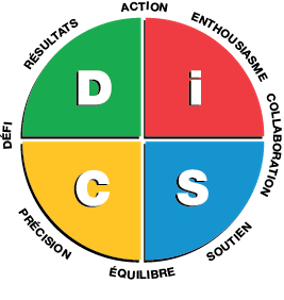One of the best ways to practice recognizing DiSC profiles is to practice with public figures and fictional characters. We are therefore going to start a series of articles "What is the DiSC profile of ...?" in order to gradually provide you with the tools and reading keys so that you become true experts in DiSC profiling.
Before we begin, a quick overview of the DiSC Excellence approach:
- DiSC is a reading grid of our behaviors in a situation, professional or not, a DiSC profile is therefore not an exhaustive analysis of your personality. DiSC profiles are above all a starting point for one's own understanding and the expression of one's potential and a reading tool to improve one's relational skills.
- We all have all 4 letters within us, we only express a preference for 1 or 2 letters in our behaviors.
- No personality style is better than another. Everyone has their strengths and challenges.
Disclaimer: This is primarily an educational exercise and cannot be considered an exhaustive and truthful analysis of the profile of a person, real or fictitious. This analysis is carried out with media extracts in a sporting context, so we cannot in any way assume their profile in a personal and/or extra-sporting context.
Who is Max Verstappen?
Max Verstappen is a Dutch Formula 1 driver, three-time world champion and currently in the running for a 4th consecutive title. At 27 years old, he is already considered one of the greatest drivers in history having already broken many records. He is the 3rd most successful driver in Formula 1, behind Michael Schumacher and Lewis Hamilton.
How to determine Max Verstappen's DiSC profile?
First, we will start by looking at several quotes, taken from interviews, racing radio or communication.
That's 88 missed podiums.
Finish first.
After reading this, what is your first impression? D, I, S or C?

We saw in a previous article that the DiSC model is structured around 2 axes. For the horizontal axis, between challenge and collaboration, we immediately note the competitive spirit and the will to win of the Dutch driver. This is hardly surprising for a high-level athlete, especially in a sport as competitive as Formula 1. We will therefore place him on our horizontal axis on the challenge side. For the vertical axis, between action and balance, this may seem less obvious at first glance. People who have a preference for action are more dynamic and daring, while those who prefer reflection are more methodical and cautious. Since the DiSC style is not only limited to our verbal but also our behaviors, we can see that Max Verstappen has much more affinity with action, especially in his driving style, which is extremely offensive and daring.
After this little analysis we can therefore classify Max Verstappen as a D profile.
Reminders on profile D
Priorities
- Get immediate results
- Act
- Challenge yourself
- Challenge others
Motivations
- Power and Authority
- Competition
- Success
Features
- Self-confidence
- Direct character
- Firmness
- Risk taking
Means of influence
- Assertiveness
- Insistence
- Competition
Excessive behavior
- Need to win, generating win/lose situations
Reactions under stress
- Impatience and increased demands
- Lack of interest in others
- Insensitivity
Fears
- To be exploited
- Loss of control
- Vulnerability
D-style people are typically tenacious and results-oriented. Always looking to prove their worth, they are constantly seeking new challenges and opportunities.
They also value action, aiming to achieve their goals quickly and with determination.
Adopting a fast pace, they prefer exchanges to get straight to the point.
In addition, D-style individuals enjoy challenges. Eager to control outcomes, they regularly ask questions and demonstrate independence of mind.
Conclusion
Through this case study, the most important thing is to understand how to gauge a person to draw a DiSC profile. We must try to place the person on both axes by asking ourselves these 2 questions: is he or she focused on challenge or collaboration? Is he or she focused on action or reflection?
Obviously, placing a person on the DiSC is not an end in itself, the most important thing is to do it for something: to improve communication with this person, to provide them with a work environment adapted to their needs, for a reconversion etc.
We will continue to present the analysis of other personalities, real or fictional, to help you understand the differences between each profile. Max Verstappen is a great example to start with because he presents an extremely marked D-style personality in his sporting context. D-profiles are often extremely high performers in adversity, so you will find many of them in high-level sport.



